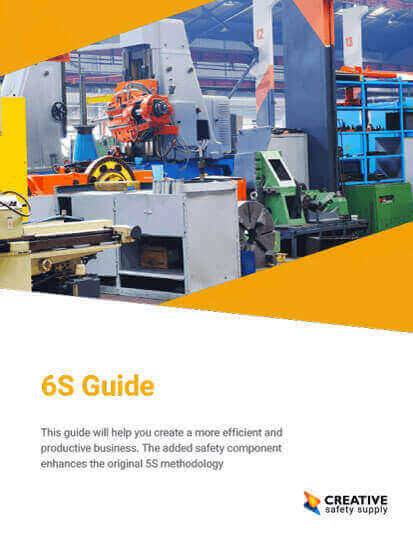
In the dynamic landscape of industrial and organizational management, the concept of 6S safety has emerged as a powerful force for transforming workplaces into thriving hubs of efficiency, organization, and employee well-being. As organizations strive to optimize their processes, the question arises: What is 6S safety, and how does it contribute to the overall success of Lean principles? In this in-depth exploration, we unravel the intricacies and rules of 6S safety, dissect its core components, and uncover its profound impact on the safety landscape of workplaces. Through a comprehensive understanding of 6S safety, organizations can chart a course toward a safer, more productive, and harmonious work environment.
Unpacking 6S Safety: An Integrated Approach
A simple definition of "6S safety" could be: A harmonious integration of Lean principles and safety practices. This methodology encapsulates a meticulous and strategic approach to organizing, standardizing, and maintaining a workplace that ensures the well-being of employees while optimizing operational efficiency.
The Six Pillars of 6S Safety
The key to 6S safety is guided by six foundational pillars, each with a unique purpose and contribution to the overarching goal:
- Sort: The first pillar, "Sort," involves the meticulous process of decluttering and organizing the workspace. By eliminating unnecessary items, tools, and equipment, the workspace becomes a safer environment with reduced tripping hazards and a streamlined layout that minimizes unnecessary movement. This decluttering not only enhances safety but also paves the way for heightened efficiency.
- Set in Order: "Set in Order" emphasizes the strategic arrangement of remaining items. Tools, materials, and equipment are placed in logical positions, enabling easy access and reducing the risk of accidents caused by awkward movements or reaching for items. This arrangement not only supports efficient operations but also contributes to a safer work environment.
- Shine: The "Shine" pillar centers on cleanliness and regular maintenance. A clean workspace not only boosts employee morale and productivity but also contributes to safety. By removing debris, spills, and potential obstacles, organizations minimize the risk of slips, trips, and falls.
- Standardize: "Standardize" introduces protocols and guidelines to ensure consistency in the maintenance of the workspace. This step not only prevents backsliding into disorder but also creates a reliable environment where employees know what to expect, reducing the risk of accidents caused by unexpected changes.
- Sustain: "Sustain" embodies the commitment to maintaining the achieved standards over time. It fosters a culture where safety practices are not just a one-time effort but a continuous commitment. By nurturing this culture, organizations empower employees to actively participate in the safety process, report potential hazards, and ensure safety remains a priority.
- Safety: The final pillar, "Safety," holds the essence of employee well-being. It involves the identification and mitigation of potential hazards, the provision of necessary personal protective equipment (PPE), and the establishment of clear safety protocols. Prioritizing safety safeguards employees against accidents and injuries, ensuring their health and security.
The Seamless Synergy Between 6S and Safety
The beauty of 6S safety lies in its inherent synergy between efficiency and well-being. As organizations align their processes with the 6S safety principles, they simultaneously create an environment that is conducive to both operational excellence and employee safety.
Cultivating a Culture of Safety through 6S
Beyond the procedural aspects, 6S safety has the power to foster a culture of safety. By involving employees in the implementation and maintenance of 6S safety practices, organizations empower individuals to take ownership of their workspaces and well-being. This proactive engagement transforms safety from a mere guideline into a shared value.
The Role of Leadership in 6S Safety
The successful implementation of 6S safety requires active leadership involvement. Leaders set the tone by prioritizing safety in their communication, resource allocation, and support for safety initiatives. When leaders visibly champion safety, it sends a powerful message that resonates throughout the organization.
The Quantifiable Impact of 6S Safety
Measuring the impact of 6S safety goes beyond subjective assessments; it involves tangible and quantifiable outcomes. Organizations that embrace 6S safety often experience:
- Reduced Incidents: The proactive identification and mitigation of hazards lead to a significant reduction in workplace accidents and injuries.
- Enhanced Efficiency: The organization benefits from streamlined processes, minimizing downtime caused by accidents or unsafe conditions.
- Improved Morale: Employees work in an environment where their safety is prioritized, leading to improved morale and job satisfaction.
- Operational Savings: Reduced accidents, improved efficiency, and increased employee morale collectively contribute to cost savings and a positive impact on the bottom line.
What is 6S safety? It is a holistic approach that unites Lean principles with safety practices to create a workplace that embodies efficiency, organization, and well-being. As organizations embark on the journey of 6S safety, they align their goals of process optimization with the inherent commitment to employee safety. Through the meticulous application of the six pillars of 6S safety, organizations foster a culture of continuous improvement, engage employees in the safety process, and yield tangible benefits that extend beyond efficiency. In the realm of Lean Manufacturing, 6S safety stands as a beacon that guides organizations toward a future where safety and success are harmoniously intertwined.
Similar Questions
- What are the Rules of 6S Safety?
- How Does 6S Safety Work?
- What is the Definition of 6S?
- How Can 6S Improve Workplace Safety and Reduce Incidents?
- How Do I Use 6S for Safety?
- When is the Best Time to Set Up a 6S Safety Program?
- Can You Use a Checklist for 6S?
- How does Employee Engagement Affect 6S Implementation?
- Who’s Responsible for 6S?

